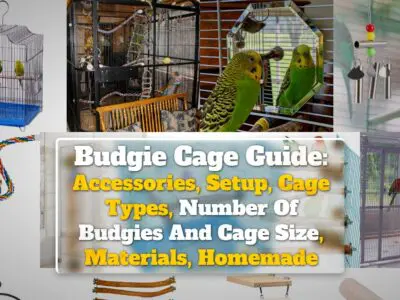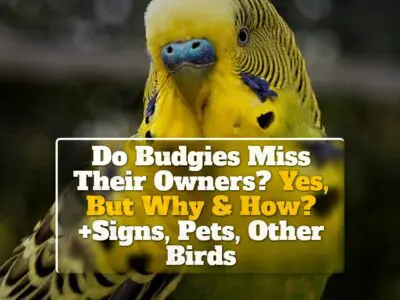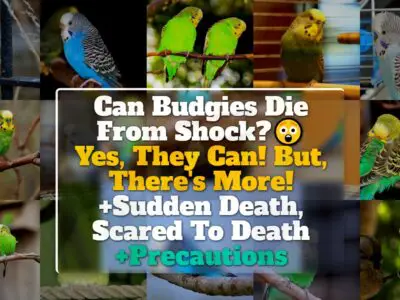To get a budgie out of its cage, especially if it’s scared, untamed, or new, understand its behavior.
Budgies might be reluctant to leave due to boredom, stress, or unfamiliar environments.
Observing signs like a defensive posture or excessive chirping can provide insights.
Preparation includes making the environment inviting, removing potential threats, and establishing bird-safe zones.
Consistent interaction, positive reinforcement, and the use of treats can build trust.
Techniques vary based on the budgie’s personality: patience for scared ones, the night light trick for untamed, and establishing a bond for new ones.
Budgies are endearing creatures, each with its unique personality and quirks. Yet, convincing them to exit their cage can sometimes be a test of patience.
Having had budgies of my own, I’ve crafted this guide to assist you in understanding and navigating these challenges.
Whether your budgie is scared, untamed, or new, I believe my experiences, insights, and observations will be invaluable in your journey to strengthen the bond with your feathery friend.
Understanding Budgie Behavior
Budgie behavior is a fascinating realm that reveals much about their comfort and state of mind.
Why Budgies Might Be Reluctant to Leave the Cage?
A budgie’s reluctance to leave its cage can stem from various reasons:
- Boredom: Just like us, budgies can get bored. If there’s nothing enticing outside the cage, they might prefer staying inside where their toys and familiar environment are.
- Stress: Birds, including budgies, can get stressed by sudden changes, loud noises, or unfamiliar faces. This stress can make them hesitant to leave their safe space.
- Illness: If a budgie is not feeling well, it may not show the usual enthusiasm to come out and play. It’s essential to observe them and seek veterinary advice if needed.
- Unfamiliar environment: If you’ve recently moved your budgie’s cage to a new location or introduced new items around it, the budgie might feel safer inside until it gets used to the changes.
Signs That a Budgie Is Avoiding Cage Time
Observing your budgie is key to understanding if they are avoiding spending time outside their cage:
- Defensive posture: If a budgie stands tall, fluffs up its feathers, and looks alert, it may be wary of something outside.
- Excessive chirping or silence: While budgies are naturally chirpy, too much chirping or sudden silence can indicate discomfort or anxiety about leaving the cage.
- Avoidance of human presence: Budgies, especially those not used to human interaction, might stay at the farthest end of the cage when someone approaches, signaling their reluctance to interact.
Budgie Emotions and Energy Levels
Just like us, budgies have emotional highs and lows:
- Understanding the mood swings: Budgies can be playful at one moment and then quiet the next. Recognizing their mood swings helps in determining the best time to let them out or when to give them some alone time.
- Importance of positive energy and emotions: A happy, active budgie is more likely to be curious and willing to explore outside the cage. Regular interaction, playtime, and a variety of toys can ensure they have positive energy and emotions.
Preparing for a Safe Budgie Exit
Helping a budgie feel secure enough to leave its cage requires a mix of a friendly environment and building a bond of trust.
Let’s dive into the steps to prepare for your budgie’s safe exit.
Setting the Stage for a Comfortable Environment
Before letting your budgie out, it’s essential to make sure the room is welcoming and safe.
- Making the room inviting: Use soft lighting and play gentle, calming sounds. Imagine creating a cozy room where a small bird would love to explore.
- Removing potential threats or scary items: Things like large moving objects, loud appliances, or even other pets can be scary for a budgie. It’s a good idea to turn off loud electronics and ensure the room is free of any perceived threats.
- Bird-safe zones and no-fly zones: Establish areas where your budgie can perch safely, like a dedicated playstand. Make sure there are no places where the budgie could get stuck or injured, like open windows or ceiling fans.
Trust Building Techniques
Building trust is the cornerstone of a good relationship between you and your budgie.
- Establishing trust through consistent interaction: Spending quality time with your budgie daily, talking softly, and being around its cage can help the bird recognize you as a friend.
- Positive reinforcement and patience: When your budgie does something right or shows curiosity, praise it with a soft voice. Always be patient, as pushing a budgie too fast can set back trust-building efforts.
- Treats as encouragement: Budgies love treats! Offering a small treat, like millet, can motivate them to come out of the cage or perch on your hand. It’s like giving them a little reward for being brave.
Techniques for Various Budgie Personalities
Every budgie is unique, much like humans. They can have a range of personalities, from being scared to untamed or just being new to their environment.
Scared Budgies
Scared budgies often need a little extra care and attention. Recognizing their fear and knowing how to comfort them can make a big difference.
- Tips for dealing with a fearful budgie: Approach them gently and talk in a soft voice. Quick movements can startle them, so try moving slowly around the cage.
- Calming techniques and patience: Playing soft music or bird chirping sounds can make a budgie feel more at ease. Remember, it might take time for them to adjust, so always be patient.
Untamed Budgies
Untamed budgies haven’t had much human interaction, making them a bit more challenging to handle, but not impossible!
- The challenge of untamed birds: They may not recognize human hands as safe, so they might be more reluctant to step up or come out of their cage.
- Using the night light trick: Budgies have poor night vision. By dimming the lights and using a flashlight or night light, you can guide them more easily without startling them.
- Hunger: a natural lure: If an untamed budgie is hesitant to approach, sometimes their hunger can work to your advantage. Holding a treat like millet can encourage them to come closer or even perch on your hand.
New Budgies
When budgies are new to a home, they’re experiencing everything for the first time, which can be overwhelming.
- First-time out experiences: The first time out can be scary for a budgie. Keep the room quiet and free from any disturbances, and let them explore at their own pace.
- Establishing a bond from day one: Spend time near their cage, talk to them, and offer treats through the cage bars. This helps the budgie recognize you as a friendly presence.
- Best practices for the first exit: Ensure the room is safe and that there are no hazards. Keep other pets out of the room, and maybe introduce a playstand or perch outside the cage to encourage them to venture out.
Getting Your Budgie Back in the Cage
Handling a budgie outside of its cage can be a delightful experience for both the owner and the bird.
However, it’s equally important to understand how to safely get them back inside without causing stress or harm.
Why Budgies Might Avoid Returning to the Cage?
Sometimes, budgies may not seem keen on returning to their cages. Let’s understand why.
Preference for freedom
Like any creature, budgies enjoy the freedom of flying around and exploring.
When outside the cage, they get a chance to stretch their wings and enjoy a larger space.
Negative cage environment
If the cage is too small, dirty, or doesn’t have entertaining toys, a budgie might avoid returning to it.
They prefer environments where they feel safe and entertained.
Practical Methods for a Safe Return
Ensuring a stress-free return to the cage is crucial for your budgie’s well-being.
Using treats to lure them back
Budgies love treats! Holding a treat in your hand or placing it inside the cage can be a powerful lure.
The promise of a tasty snack can make the cage more appealing.
The power of the perch
Just as you can use a perch to get your budgie out, you can also use it to guide them back in.
They find perches familiar and may be more willing to land on them.
Night-time natural instincts
Budgies have a natural instinct to find a safe spot when it gets dark.
Dimming the lights can trigger their instinct to return to the safety of their cage.
Calm approach and patience
Always be patient. Avoid making sudden moves. Speak in a soft and soothing voice, letting your budgie know it’s safe to return.
What NOT to Do
It’s just as important to know what actions to avoid.
Avoid forceful methods
Never try to grab or chase your budgie. This can make them scared and distrustful of you in the future.
Avoiding stress and panic
Stay calm. If you show signs of panic, your budgie might pick up on that energy and become stressed.
Faqs
Why Won’t My Budgie Come Out?
Budgies might hesitate to come out due to fear, lack of trust, or being in a new environment.
Ensure they feel safe and that there are no sudden loud noises or potential threats around.
What are the Challenges in Getting an Untamed Budgie Out?
Untamed budgies haven’t built trust with humans yet. They might be wary of hands reaching into their cage or unfamiliar sounds.
Building trust takes time and consistent positive interactions.
What Are the Solutions When a Budgie Refuses to Return to the Cage?
Using treats is a good way to lure them back. Another method is to dim the lights, triggering their instinct to find a safe place.
How Can You Recognize a Budgie’s Reluctance to Leave Its Cage?
If a budgie backs away when the cage door is open or clings to the farthest part of the cage, it might be showing reluctance.
Another sign is if they make warning sounds when approached.
How Can You Differentiate Between a Scared, Untamed, And New Budgie?
A scared budgie might flutter frantically and make distress calls. Untamed budgies might not respond to human cues and stay away from the cage door.
New budgies are typically wary of their surroundings but might not show the defensive behaviors of an untamed budgie.
How Should You Respond to a Budgie’s Defensive Posture?
When a budgie puffs up, hisses, or tries to bite, it’s displaying a defensive posture.
It’s best to give them space and approach them calmly later. Avoid making sudden movements.
How Important Is the Cage’s Environment in Influencing a Budgie’s Behavior?
Extremely important! A clean, spacious cage with toys and perches is crucial.
A comfortable environment can reduce stress, making the budgie more amicable to interactions.
What Should Be the Ideal Frequency for Letting a Budgie Out?
It’s good for budgies to have daily flying time, ideally for about an hour.
Ensure the room is safe, and it’s best done at a consistent time each day for routine.
How Can You Best Prepare Your Home for a Budgie’s First-time Exit?
Before letting a budgie out, ensure windows and doors are closed. Remove any potential hazards like open water containers.
Turn off fans, and ensure other pets are in a different room.
It helps create a safe environment for exploration.
Why Might a Budgie Show Reluctance in Returning to Its Cage After Its First Time Out?
The freedom to fly and explore can be exhilarating. A budgie might be hesitant to return because of the new experiences or if the cage environment is not appealing.
Make sure their cage is inviting with toys and treats.
What Precautions Should Be Taken When Multiple Budgies Are Together Outside Their Cages?
Ensure there’s enough space for all to fly. Watch for signs of aggression or territorial behavior.
Having multiple perches can prevent disputes. It’s like making sure everyone has their own little space.
What Role Do Cage Mates Play in a Budgie’s Willingness to Come Out or Return?
Cage mates can provide comfort and companionship. If one budgie is more adventurous, the other might follow.
However, they might also influence each other’s hesitations. Observing their interaction can provide clues on their behavior outside the cage.



